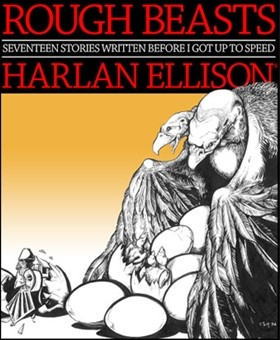 By HARLAN ELLISON (Edgeworks Abbey; 2012)
By HARLAN ELLISON (Edgeworks Abbey; 2012)
An absolute must-have collection by the inimitable Harlan Ellison. As the title warns, the stories collected here are from the early days of Ellison’s career, specifically the late 1950s, and so aren’t as strong as later works like “I Have No Mouth and I Must Scream,” “A Boy and His Dog,” etc. This is a terrific bunch of stories nonetheless, with one, 1957’s “Invulnerable,” that can stand with Ellison’s finest work.
As ROUGH BEASTS’ back cover makes clear, “Invulnerable” was supposed to be part of the 1983 collection STALKING THE NIGHTMARE, and was hotly promoted by Stephen King in his introduction to that book, yet Ellison excised it on the grounds that it wasn’t strong enough. I disagree, finding it an excellent piece of SF pulp about a literally invulnerable man whose “talents” are exploited by a corrupt future government. The tale isn’t quite the action-fest you might expect, and is actually all the better for it, with a terrifically moving last line.
Also featured is “Way of The Assassin,” a revised version of a novella that initially saw print as the notorious DOOMSMAN, copies of which Ellison was known to rip up at book signings. Having read DOOMSMAN (unfortunately!) I can attest that Ellison’s antipathy toward it is fully justified. This new version, thankfully, is much stronger, a starkly violent and picturesque adventure yarn that, as with “Invulnerable” and indeed all of Ellison’s best work, contains pertinent real world underpinnings.
Also noteworthy are the hallucinogenic “Up the Down Escalator,” about the bloody hallucinations experienced by an apparently schizophrenic murderer, the Faustian “Walk the Ceiling,” concerning a demon who bequeaths fabulous powers on a petty criminal, and “Hit-Skip,” involving a hit-and-run accident whose perpetrator gets his comeuppance in a genuinely unexpected twist ending. As for the notably bleak and nasty offerings “The Untouchable Adolescents” and “Why Did Wallace Crack?,” both prove that even back in the 1950s nobody did future shock quite like Harlan Ellison.
At least a couple of the tales live up to the book’s subtitle all too well. “Star Route” is a silly and obvious first contact story that pivots on a dumb joke unveiled in the final line, while “Machine Silent, Machine Yearning” is an equally silly tale positing that the only thing machines really need to operate efficiently is tenderness from their human users. But overall this is a vital publication, showcasing a writing talent not yet at the height of his powers but definitely on his way.
